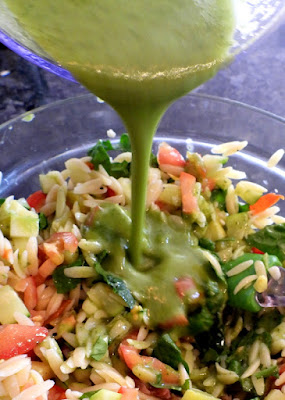PRESTO!
It's PESTO!
Basil is my favorite summer herb and this post
is devoted to this wonderfully aromatic and versatile culinary herb. A member of the mint family, Ocimum basilicum, is highly fragrant, with
a taste balancing between sweet and savory and with distinctive tones of mint,
anise, and pepper.

I’m starting off with making a big batch of pesto and
then offering suggestions for different applications of this verdant,
herbaceous mixture. Typically, pesto is
a coarse sauce of crushed basil leaves, garlic, Parmesan cheese, olive oil, and
pine nuts, generally served with pasta; however,
Rosie, being atypical, is making hers with pecans instead of pine nuts and
she’s serving it on more than just pasta.
A few caveats about pesto:
·
Get a good quality Parmigiano Reggiano cheese,
not just “Parmesan” cheese. There is a
difference. For a cheese to be labeled
“Parmigiano-Reggiano,” it must come from certain regions of Italy, notably the
neighboring regions of Parma and Reggio in northern Italy, and it must adhere
to strict requirements. Laws govern the
origin of ingredients and the method of production, with regulations including
what the milk-producing, happy, pampered cows eat (only fragrant and flavorful
wild grasses, no silage allowed) to the aging process itself. These laws of the Parmigiano-Reggiano
Consortium exist to preserve traditional methods of production and to ensure
consistency from product to product.
Look for Italy’s official label of Denominazione
d’Origine Protetta (DOP or Protected Designation of Origin) stamped on the
cheese. “Parmesan” can come from
anywhere and is an imitation. It’s the mass-produced,
bastard American cousin and no rules apply.
If you’re thinking about using
the stuff in the green can, please remove yourself from the kitchen.
·
Since the predominant tastes here are fresh
basil and Parmigiano Reggiano cheese, I’m going with a fairly neutral olive
oil, one whose flavor does not compete with the basil and cheese. My standby neutral olive oil is Bertolli
Extra Light.
·
Instead of the traditional pine nuts, I’m using
pecans because I think they taste so much better.
·
Leftover pesto freezes very well. You can freeze in ice cube trays (Does anyone
have ice cube trays anymore?), then pop into freezer bags, or you can place
plops on plastic wrap and freeze individual servings in freezer bags.
For the pesto:
1 packed quart basil leaves
5 cloves garlic
1 cup pecans
1 heaping cup grated Parmigiano Reggiano cheese
1 ¼ cup neutral flavored olive oil (I use Bertolli Extra
Light.)
½ tsp kosher salt, or to taste
In a processor, pulse basil, garlic, and pecans until
finely chopped. Slowly drizzle in olive
oil, processing until completely mixed. Pulse in cheese. Salt to taste.
For storing, I cover with a thin layer of oil and press
plastic wrap over top before sealing container.
Keeping the air out keeps it fresh and green. After 3-4 days in fridge, freeze it.

Pasta with pesto is a lovely combination. Use a pasta shape that catches the
sauce. Pesto clings best to pastas that
have grooves, ridges, curls, spirals, and twists like corkscrews. I recommend a pasta like rotini or fusilli. Cook pasta according to directions, drain,
and then spoon in pesto, tossing to coat evenly, filling in all those nooks and
crannies.
Now, you find yourself with a big batch of pesto.
What else can you do with it?

Pesto’s not just for pasta. Be creative.

Instead of your basic BLT, embellish it with pesto.
It’s a perfect condiment to enhance an already
delectable combination.
Another favorite pesto fusion is pesto pizza.
Basic pizza dough.
I like pepper on it.

Slather on some pesto.

Add sliced tomatoes and ricotta cheese.
Top with mozzarella.
 Bake until golden brown.
Bake until golden brown.
Take basic pizza dough (I used homemade, but you can use
store bought in a pinch.), slather pesto sauce over the dough, add sliced
tomatoes, plop ricotta cheese on top, then cover the whole with grated
mozzarella. Bake at 450° about 10
minutes, or until the top is bubbly and golden brown.
For a delightful appetizer or light dessert, try strawberries and watermelon together with pesto:

For simplicity itself, pair a cube of watermelon with a slice of strawberry and top with a dab of
pesto.

If you want to take it to the next level, try dribbling
on a balsamic vinegar reduction.
Mix ½ cup good quality
balsamic vinegar with 2 TB brown sugar. Heat in a small saucepan over very low heat
until thickened and reduced by almost half.
Drizzle the glaze over the strawberries.
Another use for the balsamic reduction is in a classic
Caprese Salad:

Tomatoes from the garden at their peak of flavor, fresh
mozzarella pearls, basil leaves, a dab of pesto, and a drizzling of an
excellent, fruity extra virgin olive oil along with the balsamic glaze all make
for a lovely Italian salad.
While you've got that balsamic reduction, let me tell you about one of the absolute best ways to use it -
with fresh strawberries.
Now the idea of vinegar and strawberries might seem a tad "off" to you, but you gotta try this. Particularly if you get a batch of strawberries from the store and you find out they're just not quite ripe enough. The balsamic reduction will do wonders for them. If you don't want to bother with reducing the vinegar, just sprinkle some sugar and drizzle the balsamic vinegar on top of sliced strawberries.
It's wonderful!
Enjoy!













































